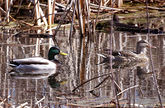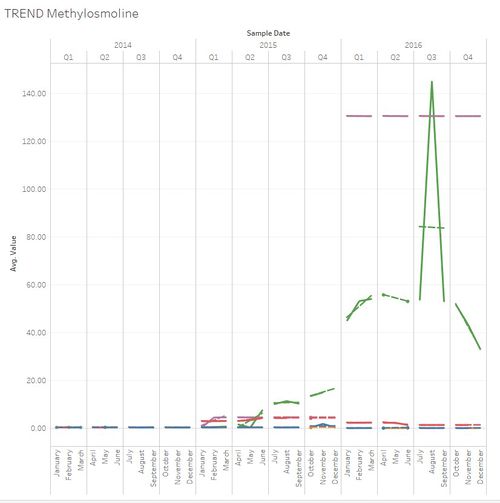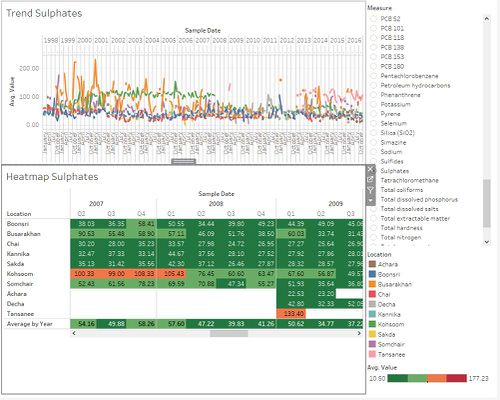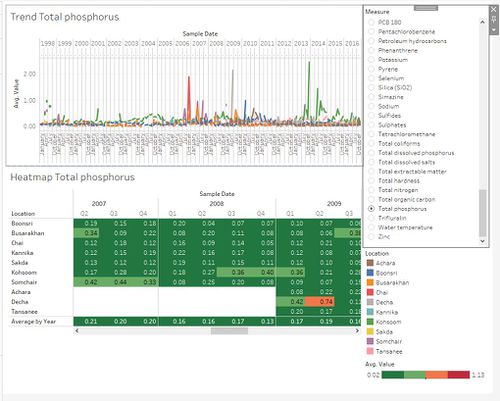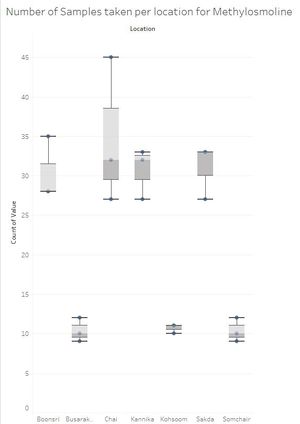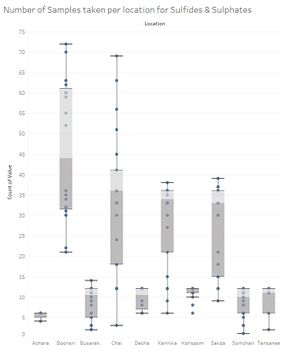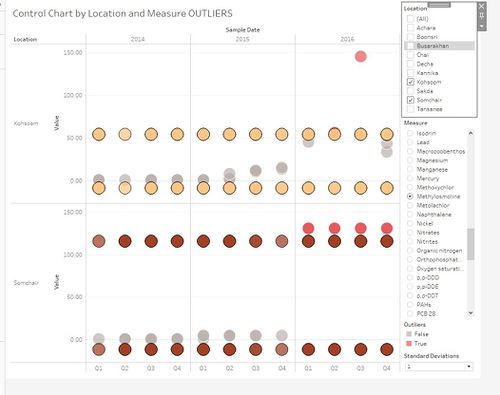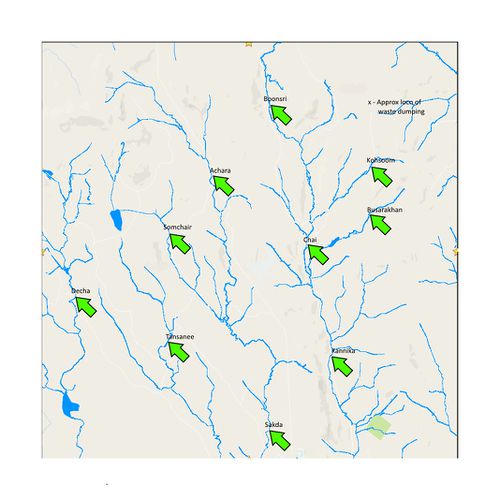Difference between revisions of "ISSS608 2017-18 T3 Assign Alejandro Llorens Moreno Visualization"
| (7 intermediate revisions by the same user not shown) | |||
| Line 68: | Line 68: | ||
<th>Visualization</th> | <th>Visualization</th> | ||
<tr> | <tr> | ||
| − | <td> <b>1. | + | <td> <b> 1. Sampling Distribution </b> |
| − | <br> | + | <br> The figure provides a clear view of missing samples in key locations. Also a very uneven sampling distribution across locations. This is a cause of major concern. We can clearly see that are missing values for samples in Achara, Decha and Tansanee. Plus a very low level of samples taken in those sites. At the same time, we can appreciate a high level of samples in Boonsri, Chai, Kannika, Sakda specially in a range of years from 2005 to 2009. Why this sudden increase in samples? </td> |
| − | <td>[[File: | + | <td>[[File:Sampling3.JPG|500px|center]]</td> |
</tr> | </tr> | ||
<tr> | <tr> | ||
| − | <td> <b>2. | + | <td> <b> 2.Methylosmoline count is limited </b> |
| − | <br> | + | <br>Methylosmoline is the major contaminant chemical. However, there are only 3 years of samples: 2014, 2015 and 2016. The sampling distribution of Methylosmoline is very different for the locations. This is a cause of concern. |
| − | + | <td>[[File:Boxplot2.JPG|300px|center]]</td> | |
| − | <td>[[File: | ||
</tr> | </tr> | ||
<tr> | <tr> | ||
| − | <td> <b>3. | + | <td> <b>3.Other chemicals have very uneven distributions in different locations </b> |
| − | <br> | + | <br> The figure shows Sulfides and Sulfates distributions of samples taken by location, as we can see they are very differently distributed with outliers clearly marked in locations like Chai or Boonsri </td> |
| − | <td>[[File: | + | <td>[[File:Boxsulfides.JPG|300px|center]]</td> |
| − | |||
| − | |||
| − | |||
| − | |||
| − | |||
| − | |||
</tr> | </tr> | ||
| + | |||
</table> | </table> | ||
| Line 103: | Line 97: | ||
<tr> | <tr> | ||
<td> | <td> | ||
| − | <br>I have created a control chart to represent outliers in 1,2 or 3 standard deviations and show specific outliers in the data. Of particular concern is the contaminant chemical Methylosmoline. The user can select a specific chemical and explore outliers in the control chart. | + | <br> A major cause of concern is the average values of Methylosmoline in locations nearby the dumping site. I have created a control chart to represent outliers in 1,2 or 3 standard deviations and show specific outliers in the data. Of particular concern is the contaminant chemical Methylosmoline. The user can select a specific chemical and explore outliers in the control chart. |
<td>The figure below shows the outliers of 1 standard deviation of Methylosmoline in two locations: Kohsoom and Somchair | <td>The figure below shows the outliers of 1 standard deviation of Methylosmoline in two locations: Kohsoom and Somchair | ||
[[File:Concern.JPG|500px|center]]</td> | [[File:Concern.JPG|500px|center]]</td> | ||
| Line 113: | Line 107: | ||
</tr> | </tr> | ||
| + | <tr> | ||
| + | <td> Extreme Outliers analysis: I have performed several analysis in different chemicals for all locations. My analysis helps identify outliers that are positive even 3 standard deviations of the average (extreme). We can spot them in different locations at specific times. This is worth an in depth analysis per location to understand the meaning of these significant outliers. | ||
| + | <td> | ||
| + | [[File:Ultimo.jpg|500px|center]]</td> | ||
| + | </tr> | ||
</table> | </table> | ||
Latest revision as of 20:47, 8 July 2018
|
|
|
|
|
Insights and answers to questions
Trends: Do you see any trends of possible interest in this investigation?
| Patterns | Visualization |
|---|---|
| 1. Hight levels of Methylosmoline detected ”
|
|
| 2.Water temperature has been increasing Water temperature is cyclical and warmer in the months from June to September (summer). However, in 2016 there’s a higher average water temperature in all locations. To be specific, in 1998 the average water temperature in all locations was 12.95 degrees. While in 2013 is 13.89, in 2014 is 14.79, in 2015 is 14.09 and in 2016 is 14.74 degrees. Global warming and other external causes can obviously affect this measurement, however, it’s worth exploring further.. |
|
| 3.There's been drastic changes in Sulfates
|
|
| 4.Other chemical changes
|
Anomalies: What anomalies do you find in the waterway samples dataset? How do these affect your analysis of potential problems to the environment? Is the Hydrology Department collecting sufficient data to understand the comprehensive situation across the Preserve? What changes would you propose to make in the sampling approach to best understand the situation?
| Patterns | Visualization |
|---|---|
| 1. Sampling Distribution
The figure provides a clear view of missing samples in key locations. Also a very uneven sampling distribution across locations. This is a cause of major concern. We can clearly see that are missing values for samples in Achara, Decha and Tansanee. Plus a very low level of samples taken in those sites. At the same time, we can appreciate a high level of samples in Boonsri, Chai, Kannika, Sakda specially in a range of years from 2005 to 2009. Why this sudden increase in samples? |
|
| 2.Methylosmoline count is limited
| |
| 3.Other chemicals have very uneven distributions in different locations
The figure shows Sulfides and Sulfates distributions of samples taken by location, as we can see they are very differently distributed with outliers clearly marked in locations like Chai or Boonsri |
Causes of concern: do any of your findings cause particular concern for the Pipit or other wildlife? Would you suggest any changes in the sampling strategy to better understand the waterways situation in the Preserve?
| Causes of Concern | Visualization |
|---|---|
|
| The figure below shows the outliers of 1 standard deviation of Methylosmoline in two locations: Kohsoom and Somchair |
| Suggestions for sampling strategy: i suggest some changes in the sampling strategy: 1. More diligent sample taking in specific dates, for example every monday and thursday of the week (instead of random samples) 2. I suggest focusing on 3 groups: a main group comprising - Boonsri - Kohsoom - Busarakhan - Chai and Kannika. A second group comprising joined locations in the river like 1. Achara 2. Somchair 3. Sakda. A third group comprising: 1. Decha and 2. Tansanee. This way one could understand the impact of 1 contaminated location extending to other locations down the rivers. | |
| Extreme Outliers analysis: I have performed several analysis in different chemicals for all locations. My analysis helps identify outliers that are positive even 3 standard deviations of the average (extreme). We can spot them in different locations at specific times. This is worth an in depth analysis per location to understand the meaning of these significant outliers. |
